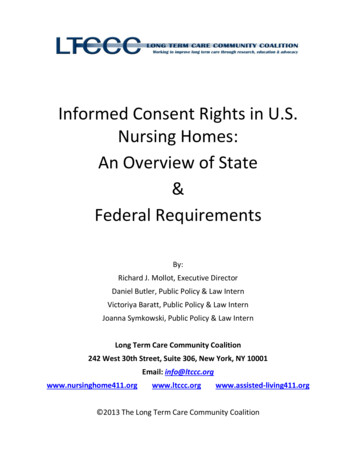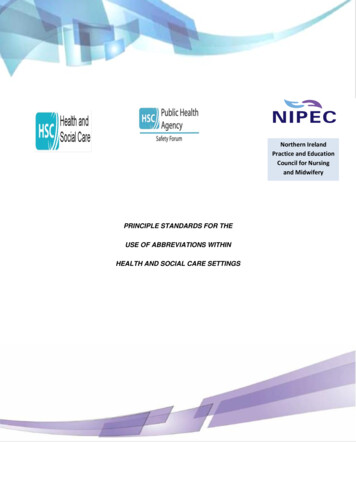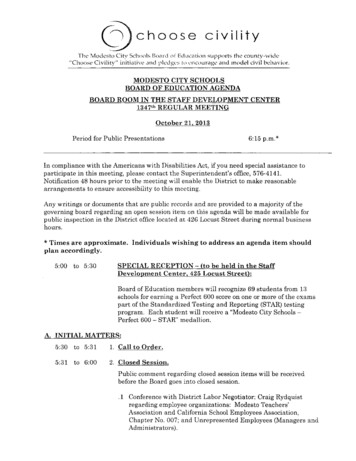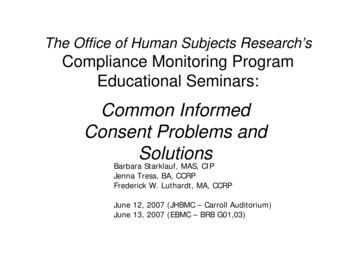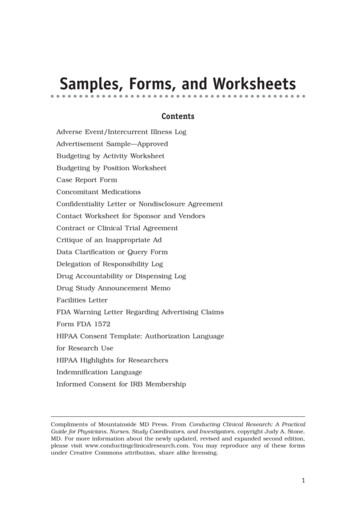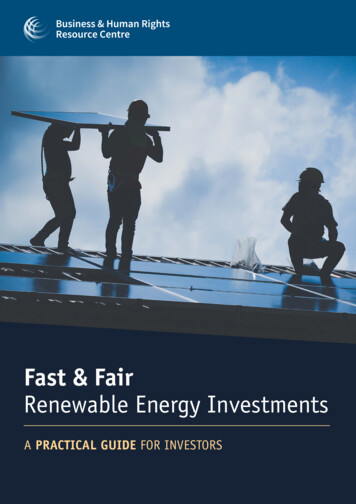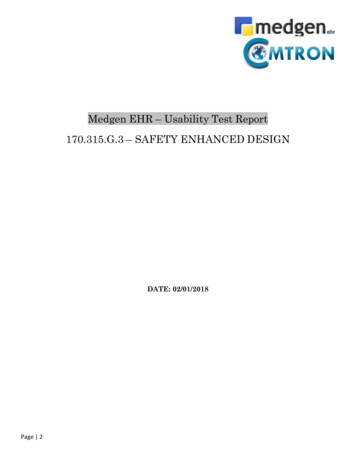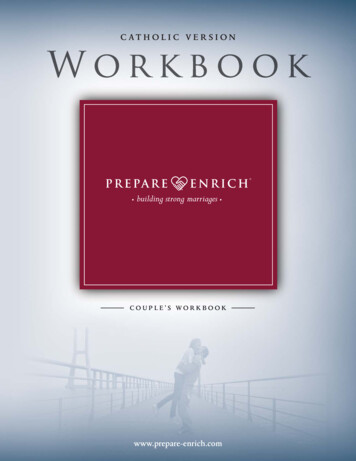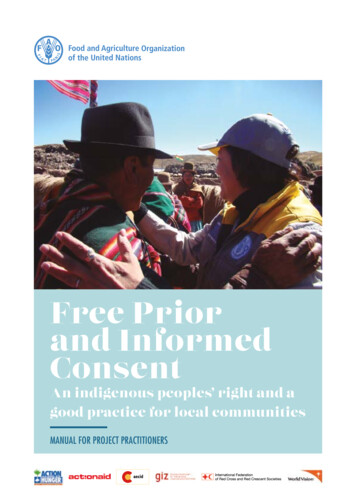
Transcription
Free Priorand InformedConsentAn indigenous peoples’ right and agood practice for local communitiesMANUAL FOR PROJECT PRACTITIONERS
Discussing project activities inMongolia. FAO/Munkhbolor GungaaCOVER PHOTO: Engaging withindigenous peoples in Bolivia. FAO/Andre Arriaza2
FREE, PRIOR AND INFORMED CONSENT MANUALTable of contents2.1. Identify the Indigenous Peoples concernedand their representatives PAGE 20PAGE 4FOREWORD2.2. Document geographic anddemographic information through participatorymapping PAGE 21PAGE 8ACRONYMS AND ABBREVIATIONS2.3. Design a participatory communicationplan and carry out iterative discussions throughwhich project information will be disclosed in atransparent way PAGE 23PAGE 10ACKNOWLEDGEMENTS2.4. Reach consent, document IndigenousPeoples’ needs that are to be included into theproject, and agree on a feedback and complaintsmechanism PAGE 25PAGE 11INTRODUCTIONPAGE 122.5. Conduct participatory monitoring andevaluation of the agreement PAGE 29SECTION 12.6. Documenting lessons learned PAGE 30FUNDAMENTALS1.1. Who are Indigenous Peoples? PAGE 12PAGE 311.2. What is Free, Prior and Informed Consent?Who has the right to it? PAGE 12SECTION 31.3. Key elements in Free, Prior and InformedConsent PAGE 15REFLECTING FPIC IN YOUR ORGANIZATION1.4. When is Free, Prior and Informed Consent(FPIC) required? PAGE 173.2. FPIC integration through the humanrights-based approach PAGE 341.5. What are the benefits of the FPICprocess? PAGE 173.3. Ensuring consistency when applying FPIC inan Organization PAGE 36PAGE 193.4. Resources required to ensure FPICimplementation PAGE 383.1. The FPIC regulatory framework PAGE 31SECTION 2PAGE 40IMPLEMENTING FREE, PRIOR AND INFORMEDCONSENT (FPIC)ANNEXES3
FOREWORDForewordINDIGENOUS PEOPLES THE STEWARDS OFNATURAL RESOURCES AND GUARDIANSOF BIODIVERSITY AND THEIR RIGHT TODEVELOPMENT AS A BASIC HUMAN RIGHTSBASED PRINCIPLEbeing decimated, dispossessed of their lands andforcibly relocated.The United Nations Economic and Social Councilestimates that there are around 400 millionindigenous peoples, or five percent of the totalworld population, spread over 90 countries.They have been present for thousands of years,preserving their language, traditions, culture andlivelihoods, many times barely surviving by livingin isolated and remote areas.On the other hand, scientists increasinglyrecognize what indigenous peoples have beenvoicing for decades: while holding much of theworld’s diversity in terms of culture, languageand spirituality, indigenous peoples are also thestewards of natural resources and guardians ofbiodiversity. This has brought increased interestto indigenous peoples in the aftermath of theclimate change negotiations during COP 21 inParis 2015, in that indigenous peoples hold someof today’s answers to tomorrow’s challenges.They face critical challenges for their survival andthe preservation of their cultures. They typicallyhave higher rates of poverty, food insecurity andmalnutrition than non-indigenous populations.While accounting for only five percent of theworld’s population, they constitute 15 percent ofits poor.In 2007, the UN General Assembly adoptedthe United Nations Declaration on the Rightsof Indigenous Peoples, recognizing their rightsand making specific mention of Free, Prior andInformed Consent (FPIC) as a pre-requisite forany activity that affects their ancestral lands,territories and natural resources.Public attention is increasingly focusing onindigenous people’s issues for a variety of reasons.On the one hand, their rights, territories andlivelihoods are seriously threatened by theworld’s demographic pressure, compounded bythe extractive industries’ appetite for resources.A widespread lack of respect of their culturesand rights has resulted in many communitiesDespite its approval in 2007, progress towardsthe implementation of FPIC has been slow anduneven by countries, private sector corporations,4
FREE, PRIOR AND INFORMED CONSENT MANUALnon-governmental organizations, internationalfinancial institutions, and the United Nations agencies.To that end, FAO partnered with ActionAgainst Hunger (ACF); Action Aid (AA); theSpanish Agency for International DevelopmentCooperation (AECID); the InternationalFederation of the Red Cross and Red CrescentSociety (IFRC); Deutsche Gesellschaft fürInternationale Zusammenarbeit (GIZ); and WorldVision (WV).In the last two or three years, development expertshave recognized that FPIC is not only importantfor indigenous peoples but it is also good practiceto undertake with local communities, as involvingthem in the decision making of any proposeddevelopment activity increases their sense ofownership and engagement and, moreover, helpsguarantee their right to development as a basichuman rights principle.As a result of this collaboration, FAO and partnerorganizations jointly developed a commonapproach to incorporate FPIC into the work ofeach respective organization. The first outcomeof this alliance is this FPIC Manual, whichwill enable field practitioners to incorporateFPIC into project and programmes’ design andimplementation, ensuring that indigenous peoples’rights are duly respected.In an FPIC process, the “how”, “when” and“with and by whom”, are as important as “what”is being proposed. For an FPIC process to beeffective and result in consent or lack of it,the way in which the process is conducted isparamount. The time allocated for the discussionsamong the indigenous peoples, the culturalappropriateness of the way the information isconveyed, and the involvement of the wholecommunity, including key groups like women,the elderly and the youth in the process, are allessential. A thorough and well carried FPICprocess helps guarantee everyone’s right to selfdetermination, allowing them to participate indecisions that affect their lives.We take this opportunity to thank our partnerorganizations for having supported this approachthat enables us to have a common voice whenimplementing Free, Prior and Informed Consentin the field.Lastly, we would like to dedicate this Manualto those indigenous leaders, women and men,who have devoted their lives to ensuring thatindigenous people’s rights are recognizedand respected. Their vision, persistence andresilience have truly inspired us and we paytribute to their sacrifices.FAO, as well as other partner organizations,have been working for many years withindigenous peoples, incorporating their views intoprogrammes on food security, nutrition, forestry,fisheries, and climate change. It was in 2015 whenFAO decided to take a step forward in respectingindigenous peoples’ rights through a moreprogrammatic approach.Daniel GustafsonFAO Deputy Director-General (Operations)5
FOREWORDA NEW COURSE IN INTERCULTURALEFFORTS AND DEMOCRACY:THE DIALOGUE FOR THE FREE, PRIOR ANDINFORMED CONSENT OF INDIGENOUS PEOPLESof community regions, migration to cities andurban disorder, are but a few examples.In recent years, we have witnessed growingvolume of outcries by indigenous peoplesdenouncing the lack of compliance with theILO Convention 169 and the UN Declarationon the Rights of Indigenous Peoples (UNDRIP),especially with obtaining their Free, Prior andInformed Consent (FPIC) before enacting projectson their land. This is in defence of their ancestralterritories and speaking out about abuses byextractive industries encroaching more andmore onto indigenous territories that are rich inuntapped natural resources.Man-made land degradation caused by extractionprojects, impacts the whole society at nationaland global level. Projects such as construction ofhydroelectric dams, oil and bio fuel plantations,massive irrigation systems, and construction ofroads, bridges and airports, among others havetaken their toll.The United Nations Permanent Forum onIndigenous Issues has received complaints fromhundreds of indigenous communities in manycountries who have witnessed atrocious acts: thetorture and death of their leaders; the destructionof their sacred places; the dismantling of theirown authority systems; the criminalization oftheir struggles to see their rights respected;rootlessness and manipulation in the purchase ofland and property rights.The pursuit of profit has led rapaciouscompanies to, seek energy sources and resourcesimpinging on indigenous lands. The focus onprofits has seen companies convince municipaland national authorities to accelerate extractiveand economic projects, without the consent ofindigenous peoples who have lived there forhundreds of years. This generates conflicts thathas led to a series of violations of indigenouspeoples’ human rights.The United Nations Permanent Forum onIndigenous Issues gives a global voice for theseindigenous peoples who see their most basichuman rights trampled on by commercialinterests. Thanks to the work of the Forum,many of the abuses committed on indigenouspeoples by companies and governments havebeen brought to light.The negative impact on the life and naturalresources of indigenous peoples is evident.Equally, it is clear that once resources areexhausted, there has been no thought to thestate of the land in the aftermath of any of theseinterventions. Desert areas, huge holes in land,water pollution (fresh and sea water), changingthe course of rivers, the reduced ability ofagricultural systems to produce food, disease,hunger, unemployment, child labour, violation oflabour laws for women and men; privatizationAt the same time, it is obvious that indigenouspeoples have not benefited from thesebusinesses or state initiatives, initiatives thatare always couched as projects for development.Indeed, it has been difficult to find a project6
FREE, PRIOR AND INFORMED CONSENT MANUALthat has brought a paradigm shift andresulted in real and genuine development tothe indigenous territories. Not surprisingly,this has generated greater distrust among theglobal indigenous leaders on the intentionsof politicians and businessmen on projectsin their territories, and thus complicates therelationship between indigenous peoples, statesand private companies.how democracy can evolve to better decisionmaking stages rooted in the respect for humanrights. In this sense, indigenous peoples cancontribute again to the betterment of humanrelationships. It is also a serious global call torethink the ethics of the creation of wealth.With this current path of entrepreneurshipand resource management, the world is headedtowards self-destruction.Equally, it is obvious that humanity needsresources for progress. Technologicaldevelopment, wellbeing and developmentenvironments cannot advance if they do not havesufficient or available resources. From whatwe have seen, despite having access to theseresources, this development does not reach thosecommunities who have been caring for theseresources in a sustainable way for hundreds ofyears. This is what needs to be changed and thisManual contributes substantively to the men andwomen of good will who support the human rightsof indigenous peoples, providing a clear path toachieve them.I appreciate the contribution that the Food andAgriculture Organization of the United Nations(FAO) is making to sensitize its own processes ofproject implementation and those of its partners.This manual accompanies the FAO Policy onIndigenous and Tribal Peoples (2010), and thecontinuous dialogue permanently installed withindigenous peoples in every region of the world,along with the Voluntary Guidelines on varioustopics. It is also a significant milestone in meetingthe objectives of the Sustainable DevelopmentGoals 2030 and the System-Wide Action Plan fora common approach to achieving the Declarationon the Rights of Indigenous Peoples. All theseinstruments are essential in our human strugglefor survival at a time when climate change is amatter of global concern.Modern entrepreneurship and new politics needto develop a culture of democratic dialogue, of fullinformation, transparency in managing affairsand solidarity in all the initiatives proposed toall the inhabitants of their countries. This isparticularly significant with indigenous peoplesgiven the conditions mentioned above.Alvaro PopPresident - United Nations Permanent Forumon Indigenous IssuesGuatelmala, 2016In fact, the pursuit of free, prior and informedconsent from indigenous peoples is the means of7
Acronyms andabbreviationsACHPRAAACFAECIDCBDESMGAfrican Charter on Human and Peoples’ RightsAction AidAction Against HungerAgencia Española de Cooperación Internacional para el DesarrolloConvention on Biological DiversityEnvironmental and social management guidelinesFAOFood and Agriculture Organization of the United NationsFPICFree, Prior and Informed ConsentGIAHSGIZGlobally Important Agricultural Heritage SystemsDeutsche Gesellschaft für Internationale ZusammenarbeitICCPRInternational Covenant on Civil and Political RightsICERDInternational Convention on the Elimination of All Forms of RacialDiscriminationICESCRInternational Covenant on Economic, Social and Cultural RightsIFRCInternational Federation of Red Cross and Red Crescent SocietiesILOInternational Labour OrganizationNGOsNon-Governmental OrganizationsUNUnited NationsUNDRIPUnited Nations Declaration on the Rights of Indigenous PeoplesUNPFIIUnited Nations Permanent Forum on Indigenous IssuesWVIWorld Vision International8
FREE, PRIOR AND INFORMED CONSENT MANUALAcknowledgementsThis manual on Free Prior and Informed Consent has been jointly prepared by The Food and Agriculture Organizationof the United Nations (FAO); Action Against Hunger (ACF); Action Aid (AA); Deutsche Gesellschaft für InternationaleZusammenarbeit (GiZ); International Federation of Red Cross and Red Crescent Societies (IFRC); Agencia Española deCooperación Internacional para el Desarrollo (AECID); and World Vision International (WVI).This manual is the result of more than a year of work and consultations with several experts. The production of the manualwas coordinated by Yon Fernández de Larrinoa, Team Leader FAO Indigenous Peoples Team with support and inputsfrom Andre Arriaza, Munkhbolor (Bolor) Gungaa, Francisco Jesús Reche Angulo and Emma McGhie, FAO experts in theIndigenous Peoples Team. Carol Kalafatic, senior consultant on Indigenous Peoples’ issues, provided most of the technicalcontent. Several experts from partner organizations provided valuable comments and edits to the manuscript, in particular:Catherine Gatundu (AA); Bratindi Jena (AA); Paola Valdettaro (ACF); Raphael Laguesse-Paquay (ACF); Amador Gómez(ACF); Kiflemariam Amdemariam (IFRC); Friedrerike Kramer (GiZ); Stella Marraccini (GiZ); Britta Krueger (GIZ); andAndre Nswana (WVI).In addition, the Manual was enriched with contributions from the FAO task force on Free Prior and InformedConsent (FPIC); the FAO Interdepartamental Working Group on Indigenous Peoples; the FAO Regional FocalPoints on Indigenous Peoples; the Guatemala UN Country Team; and The Mountain Partnership and Aigine CulturalResearch Center.We would like to thank the following people, who in one way or another have collaborated to make this manual a reality:Alberta Guerra (AA); Ruchi Tripathi (AA); Antoine Bouhey (AA); Natxo Bellés (AECID); Eva Buendia (AECID); AnnaBelen Revelles (AECID); Nathalie Bovin (IFRC); Marion Aberle (GiZ); Bojan Auhagen (GIZ); Lena Fey (GIZ); MarkusBernd Liss (GIZ); Andreas Drews (GIZ); Stella Marraccini (GIZ); Stefan Ehrentraut (GIZ); Olivier Longue (ACF); WalterMiddleton (WVI); Douglas Brown (WVI); and Laurent Thomas; Marcela Villarreal; Francesco Pierri; Rolf Hackbart;William Settle; Mark Davis; Nadia Correale; Zofia Mroczek; Richard Moon; Mariangela Bagnardi; Clare Sycamore;Daniela Morra; Francesca Romano; Valeria Gonzalez Riggio; Paola Palestini; Chiara Pili; Sameer Karki; Florence Poulain;Jessica Sanders; Daniela Kalikoski; Martina Buonincontri; Bruna Bambini; Indira Joshi; Daniel Beltrán; Jeffrey Campbell;Caroline Devit; Amanda Bradley; David Morales; Andrew Nadeau; Beatrice Ghirardini; Fabiana Biasini; Mario Acunzo;and James Garber, all from FAO.The designations employed and the presentation of material in this information product do not imply the expression ofany opinion whatsoever on the part of the Food and Agriculture Organization of the United Nations (FAO) concerningthe legal or development status of any country, territory, city or area or of its authorities, or concerning the delimitation ofits frontiers or boundaries. The mention of specific companies or products of manufacturers, whether or not these havebeen patented, does not imply that these have been endorsed or recommended by FAO in preference to others of a similarnature that are not mentioned.The views expressed in this information product are those of the author(s) and do not necessarily reflect the views orpolicies of FAO.FAO encourages the use, reproduction and dissemination of material in this information product. Except where otherwiseindicated, material may be copied, downloaded and printed for private study, research and teaching purposes, or for usein non-commercial products or services, provided that appropriate acknowledgement of FAO as the source and copyrightholder is given and that FAO’s endorsement of users’ views, products or services is not implied in any way.All requests for translation and adaptation rights, and for resale and other commercial use rights should be made via www.fao.org/contact-us/licence-request or addressed to copyright@fao.org.FAO information products are available on the FAO website (www.fao.org/publications) and can be purchased throughpublications-sales@fao.org.9
INTRODUCTIONTANZANIA.Pastoral farmers of the Maasaitribe attending a meetingwith extension workers andtechnicians from FAO. FAO/Giuseppe BizzarriNIGER.Cattle census and acceleratedpoverty reduction project. FAO/Ado Youssouf10
FREE, PRIOR AND INFORMED CONSENT MANUALIntroductionThis manual deeply rooted in a humanrights based approach, is designed to assistdevelopment organizations to respect the rightto FPIC when developing and implementingprojects affecting Indigenous Peoples.The manual contains a six-step procedure tofacilitate the FPIC process while showing itsbenefits, as well as providing the regulatoryframework to be used when mainstreamingIndigenous Peoples’ rights within organizations’policies and standards.This Free, Prior and Informed Consent(FPIC) Manual is designed as a tool for projectpractitioners (herein referred as project managers)for a broad range of projects and programmes(hereinafter to be referred to as projects) ofany development organization, by providinginformation about the right to FPIC and how it canbe implemented in six steps.The development of this manual has been theresult of a consultative process that began inJuly 2015 between FAO and a number of itspartner organizations such as Action AgainstHunger, Action Aid, Deutsche Gesellschaftfür Internationale Zusammenarbeit (GiZ),International Federation of Red Cross and RedCrescent Societies (IFRC), Agencia Españolade Cooperación Internacional para el Desarrollo(AECID) and World Vision.It is also worth mentioning that this manual doesnot aim to substitute the role of the state as theprimary duty bearer.It is important to note that this is a ‘WorkingFinal’ version of the document, meaning thatthere will be periodic updates to this versionbased on the application of this Manual,increased information and experience relatedto the application of FPIC in the field, andcontinued input and feedback from the differentstakeholders involved. For more information,please contact Indigenous-Peoples@fao.org.FPIC is a principle protected by internationalhuman rights standards that state, ‘all peoples havethe right to self-determination’ and – linked tothe right to self-determination – ‘all peoples havethe right to freely pursue their economic, socialand cultural development’. Backing FPIC arethe United Nations Declaration on the Rights ofIndigenous Peoples (UNDRIP), the Conventionon Biological Diversity and the InternationalLabour Organization Convention 169, whichare the most powerful and comprehensiveinternational instruments that recognize the plightsof Indigenous Peoples and defend their rights.11
SECTION 1: FUNDAMENTALSSECTION 1Fundamentals1.1. Who are Indigenous Peoples?“Indigenous Peoples” shall not be dependent onwhether the national government has recognizedthem as such.The development of a single definition ofIndigenous Peoples that is applicable to all of themin the world, has proved to be extremely difficult,due to the diversity between regions and countries,and the differences in background, culture,history and conditions of indigenous communities.However, in accordance with international legalagreements such as the United Nations Declarationon the Rights of Indigenous Peoples (UNDRIP),the International Labour Organization (ILO)Convention 169 and the Policy on Indigenousand Tribal Peoples by the Food and AgricultureOrganization (FAO), Indigenous Peoples share thefollowing characteristics:The term “Indigenous Peoples” in plural wasinternationally agreed by Indigenous Peoplesto encompass diverse collectives that also fit thecharacteristics outlined in the working definition(above). It can include tribes, first peoples/nations,aboriginals, ethnic groups, adivasi, janajati, oroccupational and geographical terms like huntergatherers, nomads, peasants, and hill people.1.2. What is Free, Prior andInformed Consent?Who has the right to it? They self-identify as indigenous and in somecases are recognised by other groups, or by Stateauthorities, as having a distinct collective identity;All Peoples have the right to self-determination. It isa fundamental principle in international law,embodied in the Charter of the United Nations andthe International Covenant on Civil and PoliticalRights and the International Covenant on Economic,Social and Cultural Rights. The standard, Free, Priorand Informed Consent (FPIC), as well as IndigenousPeoples’ rights to lands, territories and naturalresources are embedded within the universal right toself-determination. The normative framework forFPIC consists of a series of international legalinstruments including the United NationsDeclaration on the Rights of Indigenous Peoples(UNDRIP), the International Labour OrganizationConvention 169 (ILO 169), and the Convention on They have ancient historical ties with respect toliving in and using a specific territory; Their cultural distinctiveness is voluntary andhanded down through generations. This mayinclude aspects of language, social organization,religion and spiritual values, modes ofproduction, laws and institutions; and They have experienced or are experiencingsubjugation, marginalization, dispossession,exclusion or discrimination.It should be noted that the recognition oridentification of certain collectivities as12
FREE, PRIOR AND INFORMED CONSENT MANUALBiological Diversity (CBD), among many others, aswell as national laws (please see section 3 foradditional details).Box 2A view on the needto apply FPIC to allcommunities (by Action Aid)Box 1Article 1. InternationalCovenant on Economic, Socialand Cultural Rights, and theInternational Covenant onCivil and Political Rights.I. FPIC is an essential tool/approach to protectthe rights (human, environmental, land andcustomary) of all affected communities,especially the most vulnerable ones.II. Prior to project implementation,FPIC ensures that the identification ofaffected communities, using participatoryassessments to understand and documentthe socio-demographics, and the historical,political, and cultural dynamics of the area.“All peoples have the right of selfdetermination. By virtue of that right theyfreely determine their political status andfreely pursue their economic, social andcultural development.”III. The FPIC process guarantees the equalconsideration of the various perspectivesheld within affected communities, throughinclusive decision-making processes.FPIC is a specific right that pertains to IndigenousPeoples and is recognized in the UNDRIP. It allowsthem to give or withhold consent to a project thatmay affect them or their territories. Once they havegiven their consent, they can withdraw it at any stage.Furthermore, FPIC enables them to negotiate theconditions under which the project will be designed,implemented, monitored and evaluated.discussions and decision-making. They do so in anenvironment where they do not feel intimidated,and where they have sufficient time to discuss intheir own language, and in a culturally appropriateway, on matters affecting their rights, lands, naturalresources, territories, livelihoods, knowledge, socialfabric, traditions, governance systems, and cultureor heritage (tangible and intangible).Organizations contributing to this manual hold theview that all project-affected peoples have the rightto be part of decision-making processes in ways thatare consistent with the principles underlying theright of FPIC. It is recommended that organizationsseeking FPIC contribute to progressively enablepeoples to exercise their right to self-determinationand the capacity of states (at all levels) to provide forthe exercise of that right.Lastly, it is also important to underline that theFPIC process does not guarantee consent asa result. The result of an FPIC process can beany of the following outcomes: consent from theIndigenous Peoples’ community on the proposedactivity; consent after negotiation and change ofthe conditions under which the project will beplanned, implemented, monitored and evaluated;or the withholding of consent. It is also important tobear in mind that consent, once given, can also bewithdrawn at any stage.FPIC is not just a result of a process to obtainconsent to a particular project; it is also a process initself, and one by which Indigenous Peoples are ableto conduct their own independent and collective13
SECTION 1: FUNDAMENTALSBox 3Participation is a Human RightWhile participation has the potential to bringtremendous benefits to development projects orprograms, the concept of participation is alsofirmly rooted in human rights principles andinternational law.guaranteeing freedom of association and othercivil and political rights.Thus, rights to freedom of expression andinformation, freedom of association andassembly, and the right to participate in culturallife are key rights not just in and of themselves,but for ensuring meaningful participation.Participation is based on the key human rightsprinciples of individual autonomy and selfdetermination as part of basic human dignity.Human dignity differs conceptually from ideasoften traditionally used in development, suchas ‘satisfaction’ or ‘welfare,’ in stressing activechoice as opposed to making people “passiverecipients of benefit”.Several other international conventions havestrengthened participation for particular groups,including women, disabled people, children,minorities and indigenous peoples. One areain which significant progress has been made inrecognizing the right to participation has beenwith indigenous peoples.Participation at all stages of developmentis grounded in the first article of both theInternational Covenant on Civil and PoliticalRights (ICCPR) and the International Covenant onEconomic, Social and Cultural Rights (ICESCR),which states that all peoples have the right toself-determination and that “by virtue of thatright they freely determine their political statusand freely pursue their economic, social andcultural development.” Participation is thenfurther emphasised in the right to participation inpublic affairs articulated in ICCPR Article 25.Historically, indigenous peoples have beenforced off their ancestral lands to make way forlarge infrastructure projects, resource extractionventures, or other so-called developmentinitiatives. Without access to the land on whichthey depend, many end up in extreme poverty.In recognizing the unique identity of indigenouspeoples, international law affirms that they havethe right to decide their own future to ensuretheir cultural and physical survival. The UnitedNations Declaration on the Rights of IndigenousPeoples (UNDRIP) declares indigenous people’sparticular rights to “free, prior, and informedconsent” (FPIC) in matters which affect their livesand livelihood (UN General Assembly, 2007).Furthermore, according to the Declaration onthe Right to Development, people not only havean inalienable right to development, but also to“active, free and meaningful participation” insaid development. This would include every facetof development work, from government-initiatedinfrastructure projects, to World Bank Educationfor all projects and initiatives, to NGOsimplementing projects.There are several populations that are oftenmarginalized from participation in decisionmaking. These include women, the poor,ethnic or religious minorities. Article 2 of theDeclaration on the Rights of Persons Belongingto National or Ethnic, Religious and LinguisticMinorities affirms that “persons belonging tominorities have the right to participate effectivelyin cultural, religious, social, economic and publiclife” (UN General Assembly, 1992b). The rightto participate has also been included in severalconventions regarding specific topical areas,most notably health and the environment.According to the Office of the United NationsHigh Commissioner for Human Rights (OHCHR),this right involves expressing policy ideas,choosing policies, and implementing, monitoringand evaluating policy. Expert involvement inthese stages should be transparent and presentedin such a way that is understood by all parties.In order to ensure that people can participate,a minimum level of economic security must beensured, capacity building activities (includinghuman rights education) must occur and civilsociety should be allowed to flourish through14
FREE, PRIOR AND INFORMED CONSENT MANUAL All community members are free to participateregardless of gen
In fact, the pursuit of free, prior and informed consent from indigenous peoples is the means of how democracy can evolve to better decision-making stages rooted in the respect for human rights. In this sense, indigenous peoples can contribute again to the betterment of human relationships. It is also a serious global call to

